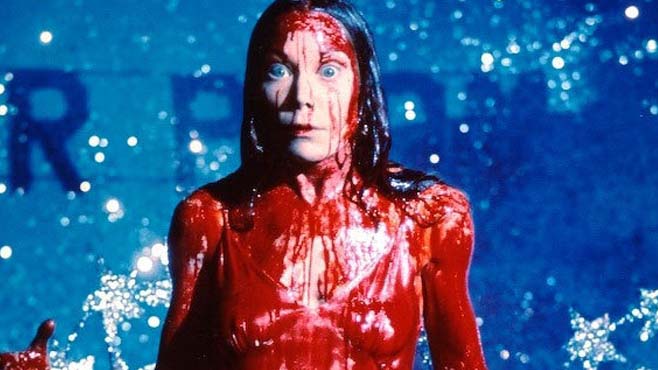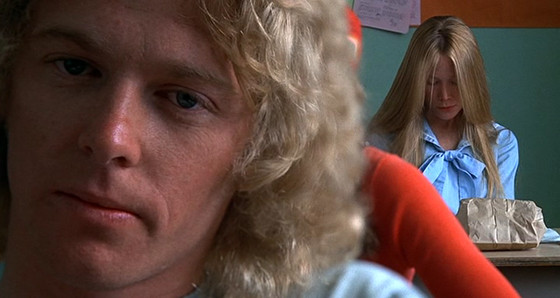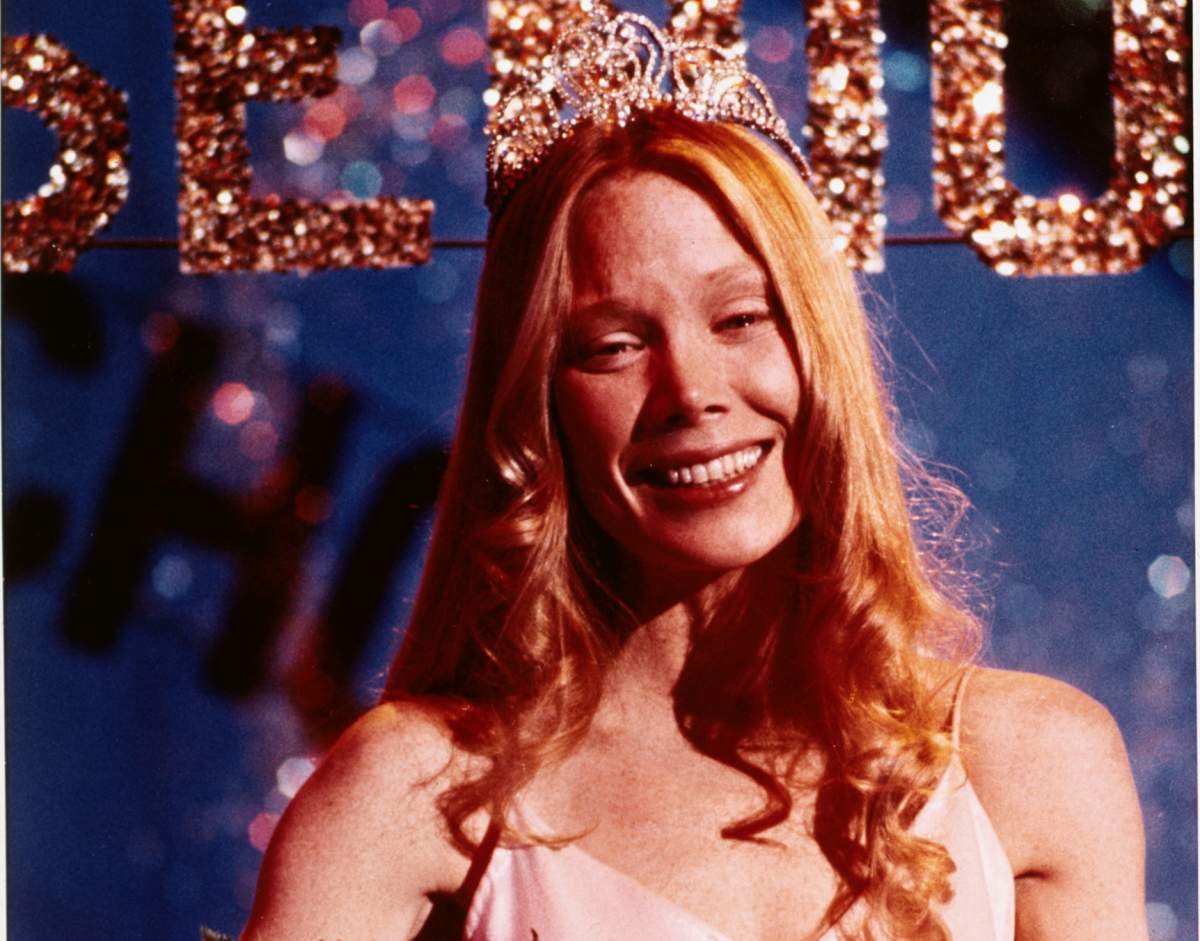
“Carrie effortlessly straddles, and frequently blurs, the line between exploitation trash and serious-minded cinema”
– Paul O’Callaghan, BFI
They’re all gonna laugh at you!
Following after the minor successes of Sisters (1973), Phantom of the Paradise (1974)––which would eventually have a substantial cult following––and Obsession (1976), Carrie would prove, once and for all, that Brian De Palma could not be dismissed as an experimental screwball. His tenth feature, De Palma shot Carrie in fifty-two days on a relatively scant budget of $1.8 million and it would go on to be his first mainstream hit and big-time breakthrough, much to everyone’s surprise. This serrated story of teen angst, religious zealotry, and a lanky teenaged introvert named Carrie White would become a watershed horror film. Who knew?
Having spent well over a decade honing his diverse and dynamic influences (including his hero, Alfred Hitchcock, rock-and-roll, and political satire), Carrie would be the perfect distillation of operatic horror melodrama/nostalgia, artfully arranged household gothic, à la mode teen movies and psychic spine-chiller.
We’d seen and been rattled by William Friedkin’s The Exorcist (1973), we’d enjoyed, identified with, and revisited George Lucas’s American Graffiti (1973) but Carrie, a kinda sorta irregular composite of those popular films would soon, in 1976, present itself like an impressive prom queen as prestige horror.
“In 1976, the first time I saw Carrie, it was the most dramatic film experience of my life. The movie had the kind of impact on me that other people experienced with ‘The Exorcist’ or ‘Jaws’ — it made my head swivel around with fear and excitement, with the sheer cinematic fairy-tale pleasure of what I was seeing, and I lived inside the experience for months.”
– Owen Gleiberman, Variety
Such great heights

Say what you will about The Shining (1980) or The Shawshank Redemption (1994) but Carrie was the first and best adaptation of a Stephen King story to the big screen and its success certainly lead to the prolific author being the most adapted genre writer of all time. King himself still regularly cites DePalma’s Carrie as the sans pareil big screen transformation, even preferring it over his best-seller, regularly calling it “a really good horror-suspense film, much better than the book.”
Ostensibly the rite de passage of Carrie White (Sissy Spacek), a religious fanatic’s daughter whose ordeal of puberty is so excruciating and unbearable for her that it flourishes startling and strange paranormal powers.
De Palma’s almost superhuman ability to couple the poetic with the execrable has never been so shattering. Carrie would launch something of a craze for teenage heroines, films featuring psychic or telekinetic heroes, and, as mentioned previously, a landslide of Stephen King novels reformatted for multiplexes.
“Though few actresses have distinguished themselves in gothics, Sissy Spacek, who is onscreen almost continuously, gives a classic chameleon performance. She shifts back and forth and sideways: a nasal, whining child pleading for her mother’s love, each word scratching her throat as it comes out; a chaste young beauty at the prom; and then a second transformation when her destructive impulses burst out and age her… … De Palma was always a sexual wit; now he’s a voluptuary wit, with the camera coming very close to Sissy Spacek’s body, and with close-ups of her wraithlike, hair-veiled face. We know her skin better than we know our own…”
– Pauline Kael
The perks of being a wallflower

The opening of Carrie embodies the signature predilection De Palma has for shock reversals between reality and fantasy. The film begins with a high school volleyball game where we see Carrie as the tormented outcast who blows the tournament and then we swiftly move into something almost like a musical fantasy of soft-core sexploitation of teenage girls showering before the reverie shatters as Carrie’s menstruation––which she doesn’t understand––terrifies her.
Still something of a hot button topic then in 1976 as it is now in 2016, even Carrie’s well-meaning high school principal is too embarrassed to say the word “period”.
Thus we witness the cruelty Carrie suffers at school soon followed by that which she suffers at home from her born-again maniac of a mother, Margaret (a terrifying Piper Laurie). This fulminating tensity and terrible abuse is a trigger for telekinesis, the audience accepts this without contention, and we proceed with confusion dilemma as Carrie’s vengeance imagining trespasses into unrestrained slaughter.
The culminating prom scene, the capsheaf of the film, is a tour de force of terror and tragedy. Carrie changes right in front of us from tender wallflower to Pale Death. Her face, her frame, her very physiognomy morphs and misshapes, exceedingly expressing the insufferable discrepancy of her experience, and ours by proxy.
“I can’t really think of any movie that I conceptualized so strongly visually and had so much time to play with the design of it before I shot it––I literally lived with [Carrie] for months and months and things like the whole use of split-screen, and diopters, and all of that was worked out like a musical score. That’s why Carrie has that carefully designed look…”
– Brian De Palma
Destroy all monsters

Almost no one at the prom is spared the spiteful lash; innocent and guilty alike are butchered and beat as De Palma unleashes the beast. A sadistic stylist, he detonates the climax deftly, employing split-screen savagery, wild point-of-view shots, slow motion emergency, stunning sound design, and more, all with the emotion and almighty impact of a force ten hurricane. Part gleeful nihilism, part ascribable payback to near universal clique-y secondary school experiences far and wide, Carrie becomes an empathetic and identifiable nightmare.
“I was surrounded by contemporaries that were George Lucas, Steven Spielberg, and Martin Scorsese. They were having tremendous successes in the same period and I just thought to myself that I was lucky to have this little horror film that had sort of done well so I could go on to make another one. I had no idea that Carrie was going to be thought of as a classical movie years later.”
– Brian De Palma
Carrie has seen a number of remakes both theatrical and made for TV, a dismal sequel, an Off-Broadway musical as well as establishing an impermeable legacy alongside its prominent iconography. That so much of Carrie’s subject matter and mettle is sympathetic and somehow still taboo may explain its enduring interest and why it keeps getting rehashed, though as anyone knows, De Palma’s is the definitive. Call it trenchant takedown of American high school or name it a heart-pounding spine-chiller, one thing is certain: Carrie is a scream.
Author Bio: Shane Scott-Travis is a film critic, screenwriter, comic book author/illustrator and cineaste. Currently residing in Vancouver, Canada, Shane can often be found at the cinema, the dog park, or off in a corner someplace, paraphrasing Groucho Marx. Follow Shane on Twitter @ShaneScottravis.